Peek into the enigmatic timeline of biblical events, where mysteries and revelations await the curious seeker.
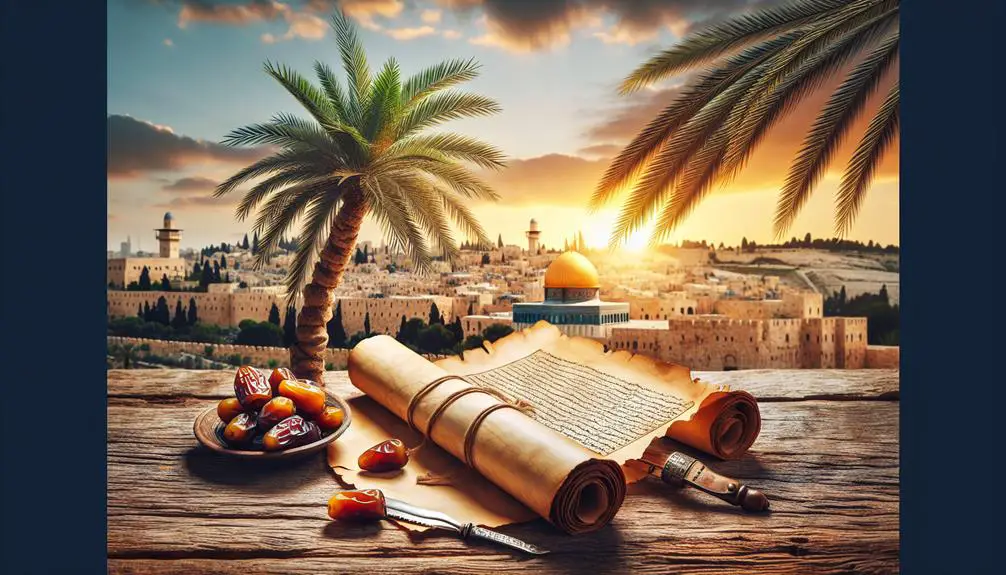
Dates in the Bible
When exploring the annals of time within the sacred texts, you'll find that pinpointing exact dates can be a bit like chasing shadows. From the moment of creation to the pivotal events of the New Testament, the Bible offers a timeline that is rich with significance, yet often shrouded in mystery.
As you embark on this journey, consider how understanding these key moments could shed light on the broader narrative of faith and history. The question of when, precisely, these events occurred invites you to explore further, uncovering the layers of meaning that have captivated scholars and believers alike for centuries.
Key Takeaways
- The Great Flood provides a detailed, timed narrative, emphasizing divine judgment and human survival.
- Noah's Ark's construction period showcases meticulous planning and execution, highlighting a significant event's timeframe.
- The Exodus from Egypt's timing remains debated, illustrating the complexities of biblical chronologies.
- King David's reign, approximately from 1010 to 970 BC, marks a well-documented era in biblical history, offering precise historical context.
Creation of the World

In the biblical narrative, the world's creation unfolds over six days, showcasing God's power and intentionality in crafting the universe and all its inhabitants. This account, primarily found in the book of Genesis, has sparked wide-ranging interpretations and debates, particularly concerning its correlation with scientific understandings of the universe's origins.
Your exploration into Genesis interpretation requires a nuanced approach, recognizing the text as a foundational component of Judeo-Christian thought. Scholars often debate whether the days mentioned are literal 24-hour periods or metaphorical, representing longer epochs in the formation of the cosmos. This distinction is critical in aligning biblical accounts with scientific theories, such as the Big Bang and evolutionary biology.
The scientific correlation aspect delves into how certain elements of the Genesis creation story can be seen to parallel scientific discoveries. For example, the sequence of creation, from light to the emergence of life, mirrors, albeit broadly, the chronological order proposed by cosmology and evolutionary theory. However, it's essential to maintain that the Genesis narrative operates within a theological framework, aimed at conveying spiritual truths rather than offering a scientific textbook.
Thus, your analysis must balance faith and reason, acknowledging the Genesis account's profound impact on understanding the world's origins while exploring its compatibility with scientific perspectives.
The Great Flood

You'll find that the chronology of the Great Flood, as outlined in the Bible, presents a complex timeline that scholars have meticulously analyzed to understand its historical context.
The construction of Noah's Ark, detailed in these ancient texts, not only highlights the engineering feats of the time but also serves as a pivotal point in biblical history, marking a moment of divine intervention and human resilience.
Analyzing these aspects allows us to grasp the multifaceted nature of this event, both from a theological and a historical perspective.
Flood Chronology
Determining the chronology of the Great Flood, as described in biblical narratives, involves analyzing ancient texts and archaeological evidence to pinpoint its occurrence within a historical timeline.
You'll find that Ararat exploration plays a pivotal role in this endeavor. Researchers meticulously examine this region, believed to be the final resting place of Noah's Ark, seeking physical remnants or geological anomalies that might corroborate the biblical account.
Simultaneously, a Gilgamesh comparison is indispensable. This ancient epic, with striking parallels to the Flood narrative, offers critical insights into the story's origins and its place in Near Eastern mythological traditions.
Noah's Ark Construction
Amidst the narrative of the Great Flood, the construction of Noah's Ark emerges as a pivotal episode, showcasing not only a remarkable feat of ancient engineering but also a profound act of faith. This endeavor involved intricate steps:
- Wood Sourcing: Selecting durable wood capable of withstanding the deluge's force was critical. The choice of gopher wood, as specified, suggests a deep understanding of materials available at the time.
- Animal Gathering: The meticulous collection of animals, two by two, underscores the enormity of Noah's task, requiring strategic planning and execution.
- Design and Construction: The Ark's dimensions and specifications demonstrate advanced knowledge, signifying a monumental undertaking in ancient shipbuilding.
These elements combined evoke a sense of awe, respect, and wonder at the dedication and foresight involved in this biblical account.
Exodus From Egypt
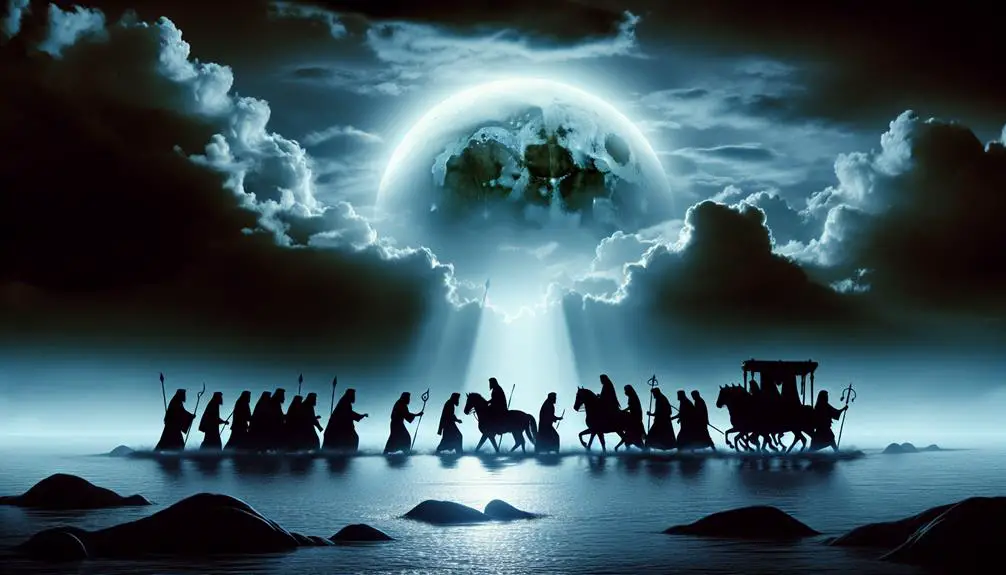
You'll find that the exact historical date of the Exodus from Egypt sparks considerable debate among scholars, who scrutinize various archaeological and textual evidence for accuracy.
The plagues, as described in biblical texts, are often analyzed for their impact on the timing of this event, suggesting a complex interplay between natural disasters and historical timelines.
This analysis not only sheds light on the biblical narrative but also offers insights into the socio-political landscape of ancient Egypt.
Historical Date Debate
The debate over the historical date of the Exodus from Egypt remains a contentious issue among scholars, with proposed dates spanning centuries. You're plunged into a world where archaeological evidence and genealogical records are at the forefront, challenging your understanding of ancient narratives.
Consider these points that evoke deep reflection:
- Archaeological evidence often provides conflicting interpretations, leaving you questioning the very fabric of biblical history.
- Genealogical records in the Bible suggest timelines that scholars tirelessly attempt to align with external historical markers.
- The lack of a consensus on a specific date deepens the intrigue, pulling you into a whirlpool of mystery and scholarly debate.
This analytical journey through time not only tests your faith but also sharpens your appreciation for the complexities of historical reconstruction.
Plagues Impact Timing
Exploring the timing of the Exodus from Egypt, it's crucial to examine how the plagues may have influenced historical and biblical chronologies. The plagues' origins, deeply rooted in ancient narratives, suggest a significant intersection with natural disasters and divine intervention.
These calamities, ranging from water turning to blood to swarms of locusts, had profound health effects on the population. They not only decimated crops, leading to famine, but also likely caused widespread illnesses. Such health crises would have crippled the Egyptian economy and social structure, creating a plausible window for the Israelites' departure.
Understanding these plagues in their historical context allows for a nuanced analysis of the Exodus timing, shedding light on the interplay between divine narrative and earthly phenomena.
Reign of King David

King David's reign, spanning approximately from 1010 to 970 BC, marks a pivotal era in biblical history, characterized by significant religious and political developments. You'll find that this time period is rich with stories that have shaped the course of religious thought and practice.
- David's Harp: As a young shepherd, David's musical talents with the harp soothed King Saul's troubled spirit, showcasing the profound impact of spiritual devotion and the arts in biblical narratives.
- Goliath Battle: David's victorious battle against Goliath, armed only with faith and a slingshot, stands as a testament to the power of belief and divine support over brute strength.
- Political Consolidation: David's unification of the Israelite tribes and establishment of Jerusalem as the political and religious center highlight his strategic acumen and vision for a united kingdom.
These events not only underscore David's multifaceted role as a musician, warrior, and statesman but also evoke deep emotional responses, from inspiration to awe, reflecting on the complexity of faith, leadership, and destiny. Through an analytical and scholarly lens, it's clear that David's reign wasn't just a historical epoch but a foundational period that continues to influence religious thought and practice today.
Birth of Jesus Christ
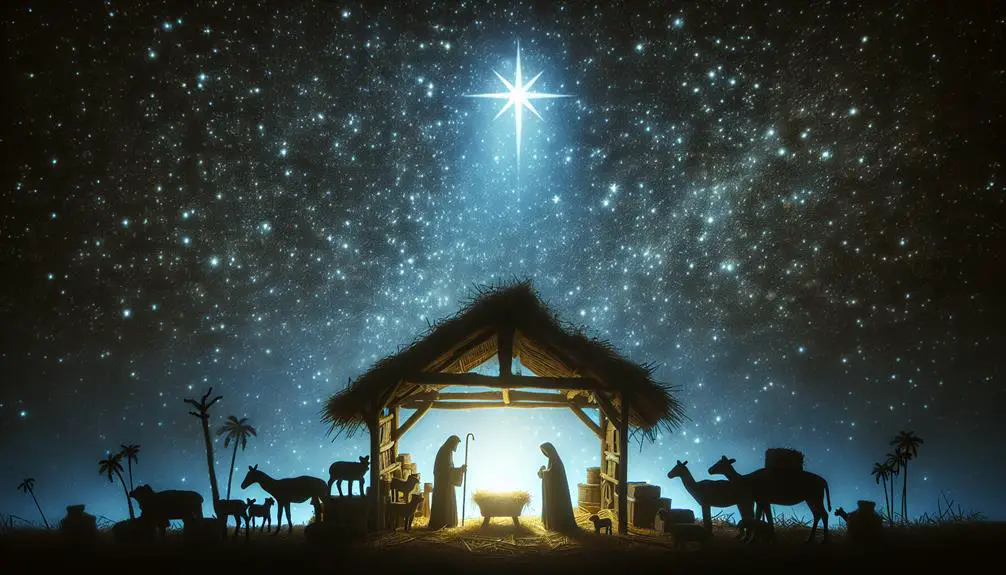
Moving from the era of King David, we now focus on a pivotal moment in biblical history, the birth of Jesus Christ, which reshaped religious narratives and belief systems across generations. This event, deeply engrained in Christian theology, hinges significantly on two phenomena: the appearance of a star and the journey of the Magi. The star's appearance, often debated among scholars, serves as a celestial marker, guiding the Magi from the East to the birthplace of Jesus. This event isn't merely an astronomical curiosity but symbolizes divine intervention and the announcement of the Messiah's arrival to the world.
The Magi's journey, prompted by this star, underscores a broader theme of search and discovery in spiritual contexts. Their voyage from distant lands to pay homage to Jesus encapsulates a meeting of the divine and the human, highlighting the universal recognition and reverence of Jesus' birth. Analyzing this journey offers insights into the interconnectedness of faith, prophecy, and celestial phenomena in biblical narratives.
Understanding the birth of Jesus through these lenses not only enriches one's grasp of Christian doctrine but also offers a nuanced perspective on how pivotal events are commemorated and interpreted in religious texts.
Crucifixion and Resurrection
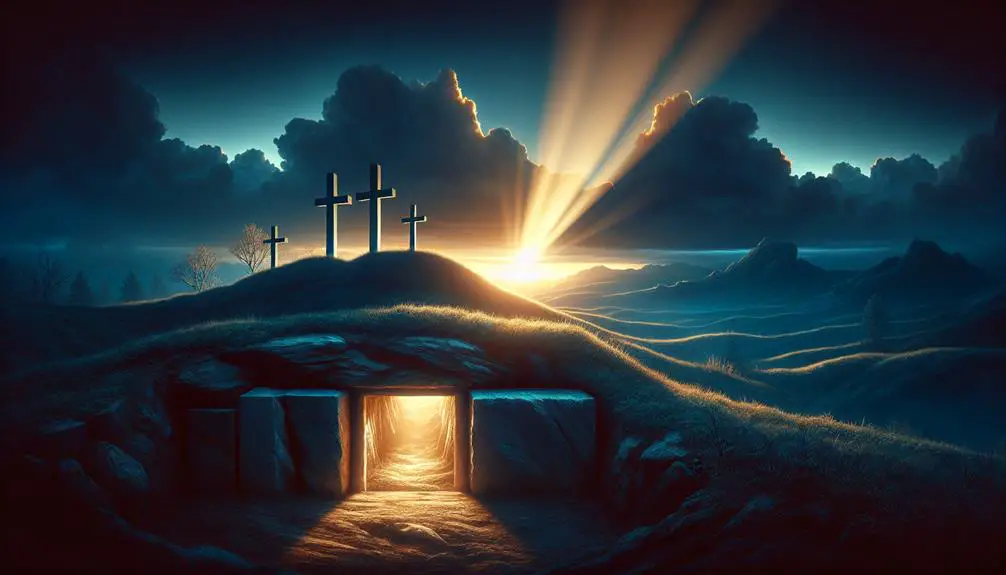
Transitioning from the birth of Jesus Christ, we now delve into the significance of His crucifixion and resurrection, events that stand at the core of Christian faith and theology. These occurrences aren't just historical landmarks but are imbued with profound theological implications, shaping the very essence of Christian doctrine and Easter traditions.
- The Crucifixion: This event represents the culmination of Jesus's earthly ministry, symbolizing the ultimate sacrifice for humanity's sins. It's a moment of profound sorrow yet monumental significance, as it fulfills ancient prophecies and illustrates the depths of divine love.
- The Resurrection: This miraculous event is the cornerstone of Christian faith, asserting Jesus's victory over death and sin. It's celebrated worldwide with Easter traditions, embodying hope and renewal for believers.
- Resurrection Appearances: These encounters, where the risen Jesus appeared to his disciples, offer compelling evidence of the resurrection's reality. They reinforce the disciples' faith, sparking the spread of Christianity with newfound vigor.
Analyzing these events through a scholarly lens, one can't help but recognize their intricate connection to Christian beliefs. They not only commemorate Jesus's life and teachings but also foster a deeper understanding of theological concepts, making Easter more than just a holiday—it's a celebration of renewal and redemption.
Pentecost
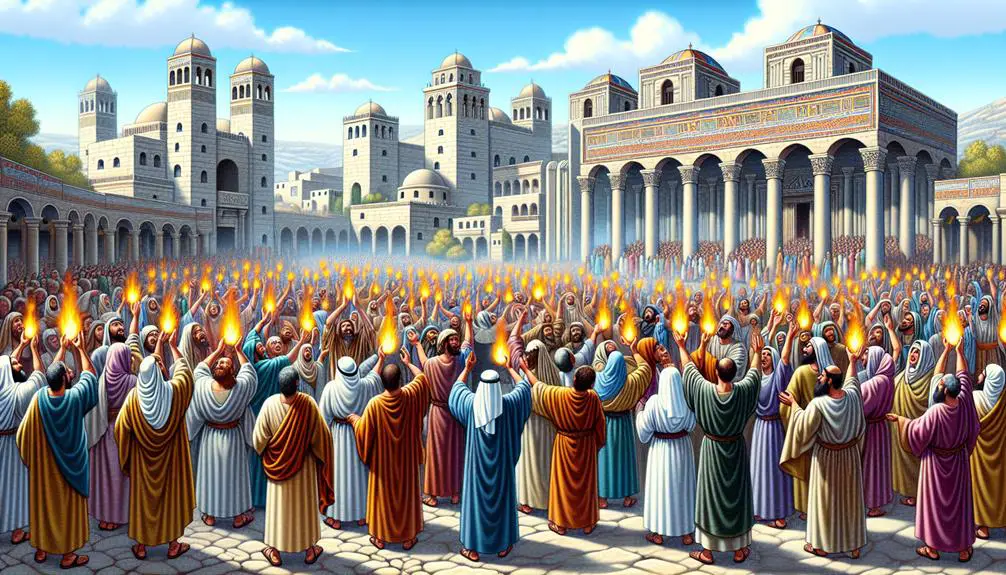
After exploring the profound significance of Jesus's crucifixion and resurrection, we now turn our attention to Pentecost, an event that marks the birth of the Christian Church through the descent of the Holy Spirit.
You'll find that the feast significance extends beyond a mere historical event; it represents the fulfillment of Jesus's promise to send the Advocate, thus empowering the apostles and forming the Church's foundation.
Pentecost, originally a Jewish feast known as Shavuot, celebrated the giving of the Torah. The Christian adaptation, occurring fifty days after Easter, symbolizes a new covenant where the law is written not on stone tablets but within the hearts of believers. This transformation highlights the cultural adaptations of religious practices, showcasing how they evolve to embody new theological insights.
Analyzing Pentecost's implications, you uncover layers of meaning. It's not just about the historical descent of the Holy Spirit; it's a celebration of unity and diversity. The event, where the apostles spoke in various tongues, underscores the universal call of the Gospel.
The cultural adaptations over centuries, incorporating symbols like fire and wind, enrich the feast's significance, illustrating the dynamic and living nature of faith traditions. Pentecost invites you to reflect on the ongoing work of the Spirit in uniting diverse peoples into one body.
Destruction of Jerusalem
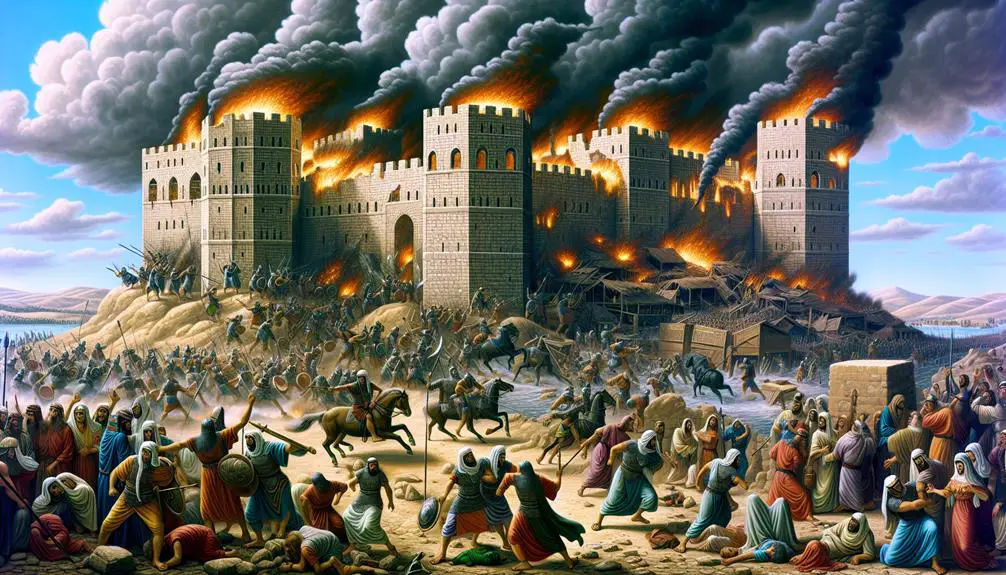
In examining the biblical narrative, the destruction of Jerusalem stands as a pivotal event, significantly altering the course of Jewish and Christian histories. This catastrophic moment, marked by Nebuchadnezzar's siege, not only reshaped the geopolitical landscape but also left an indelible mark on the religious consciousness of the time.
The role of Nebuchadnezzar, the Babylonian king, is central to understanding the magnitude of this calamity. His relentless pursuit to expand his empire led to the obliteration of Jerusalem in 586 BCE, an event that precipitated the Babylonian Exile. This period of forced displacement deeply impacted the Jewish community, shaping their identity and religious practices.
Artifact discoveries have further illuminated the historical veracity of these events. These findings, ranging from inscriptions to remnants of the ancient city's fortifications, provide tangible evidence of the siege and subsequent destruction.
To evoke the profound emotional impact of this event, consider the following:
- The loss of the Temple, the heart of Jewish worship and identity.
- The displacement and fragmentation of the Jewish community.
- The enduring legacy of resilience and faith amidst adversity.
Analyzing the destruction of Jerusalem through these lenses offers a nuanced understanding of its historical and religious significance.
Frequently Asked Questions
How Do Scholars Reconcile Differing Chronological Accounts Within the Bible and With External Archaeological Evidence?
To reconcile differing chronological accounts, you'll delve into textual criticism and interdisciplinary collaboration. You'll scrutinize ancient texts, comparing biblical narratives with archaeological findings.
This process involves rigorous analysis, where scholars cross-reference historical records and employ scientific methods. By integrating insights from various disciplines, including history, archaeology, and theology, you'll piece together a more coherent timeline.
This scholarly approach ensures a detailed, analytical understanding of the past.
What Are the Most Significant Discrepancies in Dating the Events of the Bible Compared to Secular Historical Timelines?
You're diving into a complex issue where King List discrepancies and Radiocarbon challenges stand out.
These discrepancies often cause heated debates among scholars. For instance, the dating of events like the reign of Egyptian Pharaohs doesn't always align with biblical timelines.
Similarly, radiocarbon dating of artifacts can contradict the traditional dates assigned to biblical events, pushing you to question the accuracy of historical narratives and the methods used to date them.
How Do Different Christian Denominations Interpret the Timeline of Events in the Bible, Particularly Regarding Creation?
When exploring how Christian denominations interpret biblical timelines, especially regarding creation, you'll find a rich tapestry of beliefs. Denominational beliefs vary significantly; some adhere strictly to creation myths as literal seven-day events, while others view them as metaphorical, aligning more closely with scientific understanding of the universe's origins.
This diversity reflects the broader theological spectrum, showcasing how interpretations of foundational stories can diverge based on doctrinal nuances.
In What Ways Have Recent Scientific Discoveries Impacted the Traditional Biblical Chronology?
Recent scientific advances, particularly in radiocarbon dating and genetic studies, have significantly impacted traditional views on chronology. For instance, radiocarbon dating has recalibrated our understanding of ancient timelines by thousands of years.
Genetic studies, revealing fascinating insights into human ancestry, challenge conventional timelines of human history. These discoveries offer a nuanced perspective, compelling scholars to rethink historical timelines, merging scientific data with traditional narratives in a scholarly and detailed analysis.
What Methodologies Do Historians and Theologians Use to Estimate the Dates of Less Documented Biblical Events, Such as the Lives of the Prophets or the Early Christian Church Outside of the New Testament Narrative?
To estimate dates for less documented events, you'd delve into methodologies like textual criticism and radiocarbon dating.
Textual criticism helps you scrutinize ancient manuscripts for chronological clues, analyzing variations and historical context.
Meanwhile, radiocarbon dating offers a scientific approach, measuring the decay of carbon isotopes in organic materials to pinpoint ages.
Together, these methods provide a robust framework for scholars to piece together timelines, enhancing your understanding of historical events beyond the mainstream narrative.
Conclusion
In examining the biblical timeline, it's fascinating to note that scholars have estimated the Earth's creation, as described in Genesis, to around 4004 B.C., according to Archbishop James Ussher's 17th-century chronology.
This calculation, while debated, underscores the immense time span the Bible covers. Analyzing these dates not only enriches our understanding of religious texts but also offers insights into the historical context in which these pivotal events were believed to have occurred, bridging millennia of human faith and history.



Sign up